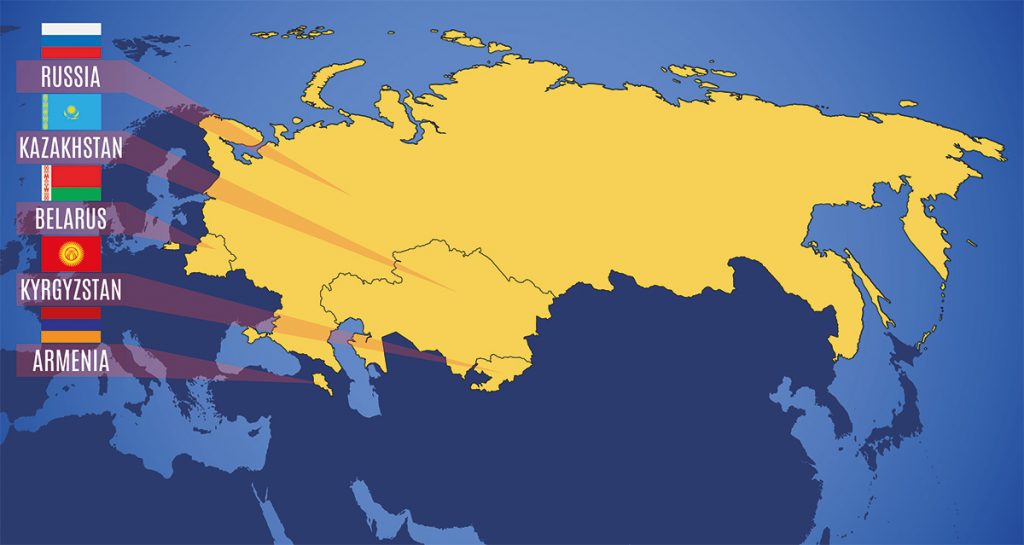Lord Waverley: The EAEU is an Alternative to the EU — But Will It Last?
The Eurasian Economic Union (EAEU) spreads across Eastern Europe and Central and Northern Asia, covering some 20 million square kilometres and representing 180 million people.

But with concern about uniting principles — aside from removal of trade barriers — there is little keeping member countries engaged.
The project had been mooted since a 1994 speech at Moscow University by Kazakhstan’s Nursultan Nazarbayev. By June of that year, plans had been drawn-up for greater economic co-operation between Eurasian countries. The EAEU came into force in January 2015, and its economies today amount to a combined GDP of $5tn.
It developed from the Eurasian Customs Union, founded in 2010 between Russia, Belarus and Kazakhstan. It was further advanced with Armenia and Kyrgyzstan signing treaties in 2014 and joining in January and August 2015, respectively.
Designed as an alternative to Western Europe’s EU customs union, the EAEU seeks to unite former Soviet states and develop an integrated and cohesive economic entity. The EAEU aims to develop a comprehensive framework for a common market in three main sectors: energy, industry and agriculture. It seeks to do this through the removal of tariffs and non-tariff barriers, and by implementing greater economic co-operation and harmonisation of domestic policy.
The EAEU had early successes. It made a strong start to integration, creating three tiers of supra-national institutions:
- Supreme Eurasian Economic Council, comprised of heads of states
- Eurasian Intergovernmental Council, comprised of heads of government
- Eurasian Economic Commission, which carries out the day-to-day work of the union.
Remove all internal customs borders, thus easing flow of goods, capital, services and labour between member countries has been notable. It has also gone some way in removing non-tariff barriers, which has caused member countries to modernise more swiftly — diversifying economies and developing more comprehensive infrastructure. It has also allowed for greater engagement by Russia and its neighbouring countries; prior to the EAEU, only five percent of Russian trade was with EAEU members.
With the EAEU focusing on economic issues, there is limited scope for political fallout between member states — allowing members to maintain political inde-pendence and divergence, without consequence. There is scope for future successes within the EAEU, especially in its specified sectors of energy, industry and agriculture — particularly if it can effectively co-operate on a macroeconomic scale.
The EAEU is not without its challenges. The relative speed at which the EAEU was created was made possible through Russia’s bilateral deals with individual member countries. This avoided complex and time-consuming multi-country negotiations, but the speed has come at a cost. Each country joined tentatively, and for differing reasons. The project was largely instigated by Russia, and member countries’ interest and commitment to the EAEU is waning.
Belarus has a strong reliance on Russian energy imports — in particular, oil and gas. It joined the union to strengthen ties to Russia and shore up energy sup-plies. Armenia had strong interests in the union’s security and economic benefits. Armenia had been nearing the conclusion of long negotiations with the EU when it decided to join the EAEU, drawn-in by reduced energy prices and security benefits in light of long-standing conflict with Azerbaijan. Kyrgyzstan relies on significant migrant labour remittances from Russia, and was interested in joining the union to expand access to the Russian labour market, and resultant financial assistance.
Kazakhstan, the second-largest economy in the union, had different reasons for joining. It desired greater free trade within the region to aid its developing economy, but was also interested in containing Russia via a regulatory agreement and framework. This is evident as Kazakhstan has made significant efforts to limit the EAEU to the economic sphere.
With terms on energy and trade loosely agreed at the EAEU’s conception, it is difficult for a comprehensive regulatory framework to be developed. The EAEU inter-governmental and supranational institutions are lacking in authority. Member countries are seemingly unwilling to cede any power or sovereignty to EAEU institutions, and are equally unwilling to abide by any new rulings.
With little-developed institutions, there is a great deal for member countries to agree on. This is hampered by competing objectives. Symptomatic of waning EAEU interest and commitment, some initial integration developments are beginning to unravel. The region is waiting to see if Uzbekistan — the most populous state in the region — will join.
Uzbekistan is increasingly seen as a rising star of emerging and frontier markets, a view validated by The Economist, which ranked it as the “most improved nation” in 2019. It has come a long way in liberalising economic and monetary policies and opening up to foreign and domestic investment over the past three years. Membership would strengthen the association.
A lack of strong governing institutions hampers long-term aims, however. Economic integration on the scale desired by the EAEU is unlikely between countries that lack common objectives. The lose agreements that facilitated the divergence and independence that drew member countries together, are the same mechanisms that are seeing the EAEU challenged.
It should be remembered that the journey, in the short 25 years since statehood was thrust upon members, could well see EAEU fulfilling potential to become a strong and inclusive economic union in a competitive common market. Iran and Mongolia have expressed an interest to join, which would expand the union’s landmass, population and collective GDP. There is talk of a single currency, too, but this long-term aim is not high on the priority list. What it signals is a view to develop the EAEU along the lines of the European Union.
Currently the EAEU faces two major issues. It lacks a comprehensive regulatory framework supported by common institutions and supranational governance. This hampers developments in policy, economic co-operation and growth. Secondly, member countries’ commitment is on the wane. Uzbekistan joining would be a shot in the arm.
Russia is struggling economically under Western sanctions. But the EAEU’s core function – to offer an alternative to the EU – remains clear and unwavering.
You may have an interest in also reading…
UN calls for China and the US to Encourage Sustainable Development
Secretary-General Ban Ki-moon has appealed to Chinese and United States-based companies to boost their efforts to achieve sustainable development and
Sustainable Stock Exchanges: Urgent Need for Simple Metrics
The 4th biennial Global Dialogue on the Sustainable Stock Exchanges (SSE) Initiative, concluded yesterday (10/14) at the United Nations Geneva
PwC Study: High Demand for Quality Infrastructure in Emerging Markets
Relentless urbanisation is driving increased demand for higher quality, more affordable and greener urban infrastructure in emerging and developed markets.


















































































